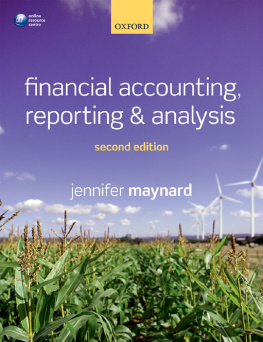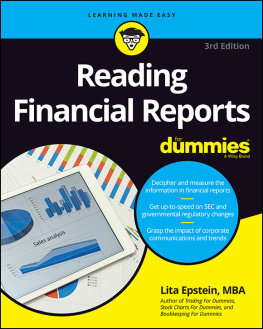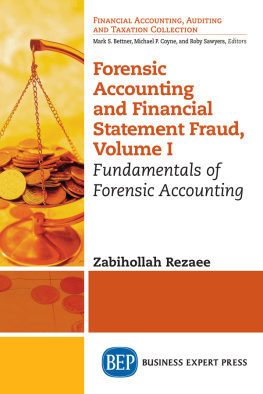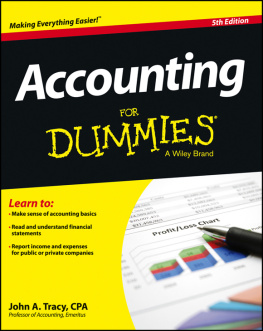Contents
Guide
Page List
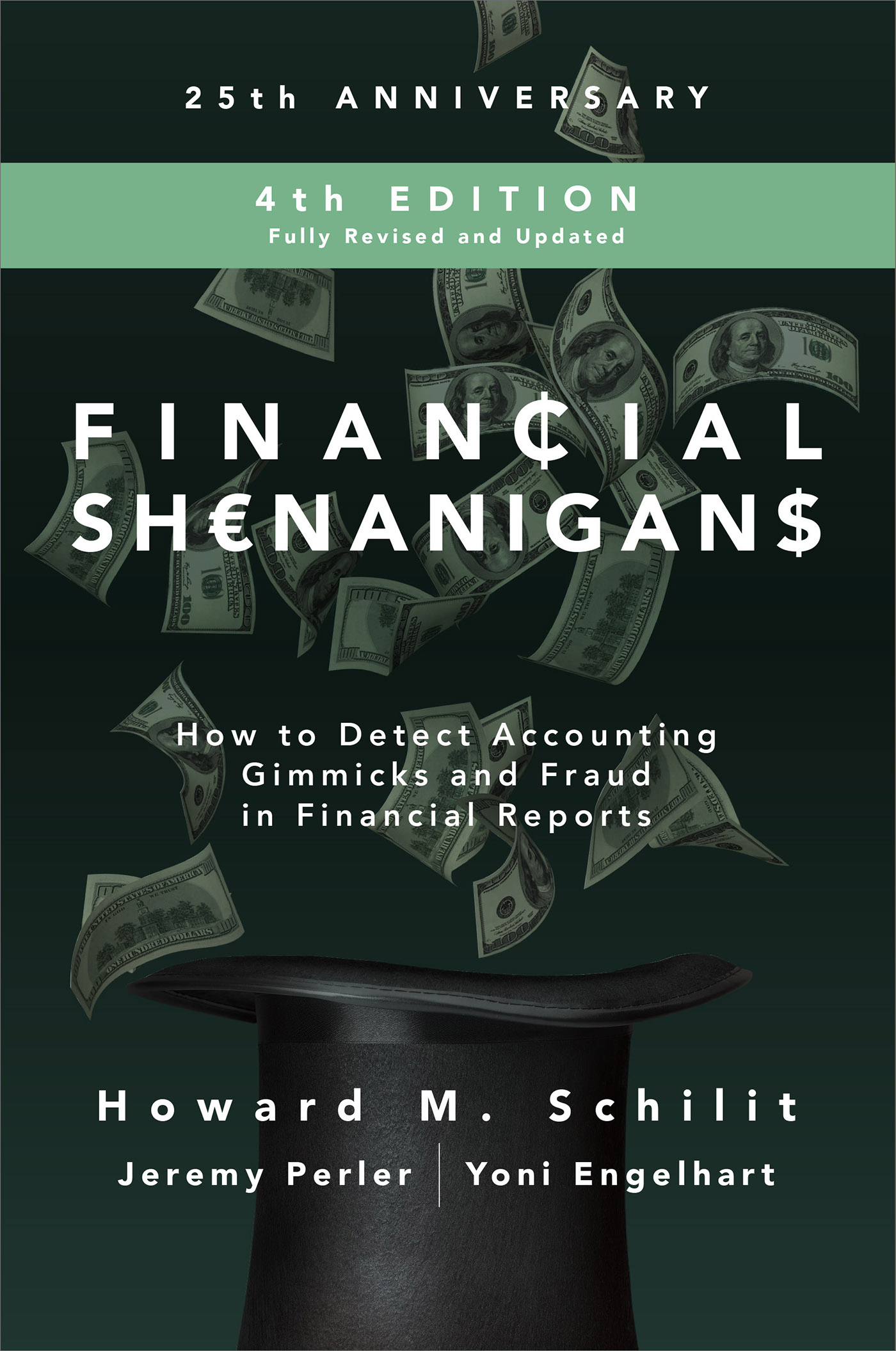

Copyright 2018 by Howard M. Schilit. All rights reserved. Except as permitted under the United States Copyright Act of 1976, no part of this publication may be reproduced or distributed in any form or by any means, or stored in a database or retrieval system, without the prior written permission of the publisher.
ISBN: 978-1-26-011727-1
MHID: 1-26-011727-8
The material in this eBook also appears in the print version of this title: ISBN: 978-1-26-011726-4,
MHID: 1-26-011726-X.
eBook conversion by codeMantra
Version 1.0
All trademarks are trademarks of their respective owners. Rather than put a trademark symbol after every occurrence of a trademarked name, we use names in an editorial fashion only, and to the benefit of the trademark owner, with no intention of infringement of the trademark. Where such designations appear in this book, they have been printed with initial caps.
McGraw-Hill Education eBooks are available at special quantity discounts to use as premiums and sales promotions or for use in corporate training programs. To contact a representative, please visit the Contact Us page at www.mhprofessional.com.
This publication is designed to provide accurate and authoritative information in regard to the subject matter covered. It is sold with the understanding that neither the author nor the publisher is engaged in rendering legal, accounting, securities trading, or other professional services. If legal advice or other expert assistance is required, the services of a competent professional person should be sought.
From a Declaration of Principles Jointly Adopted
by a Committee of the American Bar Association
and a Committee of Publishers and Associations
TERMS OF USE
This is a copyrighted work and McGraw-Hill Education and its licensors reserve all rights in and to the work. Use of this work is subject to these terms. Except as permitted under the Copyright Act of 1976 and the right to store and retrieve one copy of the work, you may not decompile, disassemble, reverse engineer, reproduce, modify, create derivative works based upon, transmit, distribute, disseminate, sell, publish or sublicense the work or any part of it without McGraw-Hill Educations prior consent. You may use the work for your own noncommercial and personal use; any other use of the work is strictly prohibited. Your right to use the work may be terminated if you fail to comply with these terms.
THE WORK IS PROVIDED AS IS. McGRAW-HILL EDUCATION AND ITS LICENSORS MAKE NO GUARANTEES OR WARRANTIES AS TO THE ACCURACY, ADEQUACY OR COMPLETENESS OF OR RESULTS TO BE OBTAINED FROM USING THE WORK, INCLUDING ANY INFORMATION THAT CAN BE ACCESSED THROUGH THE WORK VIA HYPERLINK OR OTHERWISE, AND EXPRESSLY DISCLAIM ANY WARRANTY, EXPRESS OR IMPLIED, INCLUDING BUT NOT LIMITED TO IMPLIED WARRANTIES OF MERCHANTABILITY OR FITNESS FOR A PARTICULAR PURPOSE. McGraw-Hill Education and its licensors do not warrant or guarantee that the functions contained in the work will meet your requirements or that its operation will be uninterrupted or error free. Neither McGraw-Hill Education nor its licensors shall be liable to you or anyone else for any inaccuracy, error or omission, regardless of cause, in the work or for any damages resulting therefrom. McGraw-Hill Education has no responsibility for the content of any information accessed through the work. Under no circumstances shall McGraw-Hill Education and/or its licensors be liable for any indirect, incidental, special, punitive, consequential or similar damages that result from the use of or inability to use the work, even if any of them has been advised of the possibility of such damages. This limitation of liability shall apply to any claim or cause whatsoever whether such claim or cause arises in contract, tort or otherwise.
In loving memory of Rob Schilit, Howards dear brother,
who contributed enormously to prior editions of
Financial Shenanigans, and is an ongoing source of inspiration.
He is sorely missed.
Contents
PART ONE
ESTABLISHING THE FOUNDATION
PART TWO
EARNINGS MANIPULATION SHENANIGANS
PART THREE
CASH FLOW SHENANIGANS
PART FOUR
KEY METRIC SHENANIGANS
PART FIVE
ACQUISITION ACCOUNTING SHENANIGANS
PART SIX
PUTTING IT ALL TOGETHER
Preface
Reflections on My Last 25 Years
Howard Schilit
Fall 2017
Dear Friends,
Having recently reached my sixty-fifth birthday, I began reflecting on my life and the many changes over the last quarter century since writing the first edition of Financial Shenanigans. In short, I feel very blessed. On a personal level, my wife Diane and I love spending time with our three young grandchildren, and are eagerly awaiting our fourth. Professionally, I am enjoying building my second business, a forensic accounting consultancy called Schilit Forensics, with my fantastic partners and coauthors, Jeremy Perler and Yoni Engelhart.
In addition to the research engagements we work on for our clients, we spend a fair amount of time teaching the trade of forensic accountingto investors, regulators, journalists, and graduate students. After a recent presentation at Stanfords Graduate School of Business, my partners and I realized that seven long years had passed since publication of the last edition of Financial Shenanigans and that almost 25 years had passed since the first edition. Over that time, more than 100,000 readers have purchased the book around the globe, including translations in Chinese, Japanese, and Korean. Weve learned a lot in the intervening years, and as such we felt it timely to share with you the latest accounting tricks as well as a more considered account of the most important lessons from the last quarter century.
But before turning the pages forward to begin this new edition of Financial Shenanigans, lets turn back the clock 25 years to share the beginning of my search for shenanigans and the unexpected and exciting journey since 1990.
The Beginningthe Early 1990s
As a professor of accounting at American University in Washington, D.C., I began researching the most prominent accounting frauds over the prior 40 years. Many have been documented in Accounting and Auditing Enforcement Releases (AAER) at the U.S. Securities and Exchange Commission (SEC). I began using many of those interesting vignettes in teaching my Intermediate Accounting and Auditing classes. As I saw that the students found those stories fascinating, I started publishing articles on this subject to share with a larger group. And, of course, the next logical step to reach an even greater audience was to write a book.
Publication of Financial Shenanigans and Early Years as Entrepreneur
Shortly after my forty-first birthday, in early 1993 McGraw-Hill published the first edition of Financial Shenanigans. The book introduced readers to seven broad categories of earnings misrepresentations, identified 20 discrete techniques that management might employ, and sprinkled in many examples of actual companies that had been sanctioned for tricking investors.
A few pleasant surprises emerged after the book was released. First, lots of readers reached out to thank me for shedding light on the steps that investors could take to safeguard their wealth. Second, the book had made its way into the ranks of big institutional investors, who sought to hire me to train their analysts on how to spot companies playing accounting games. Eventually they began asking me to examine the companies in their portfolios. Fortunately, on several occasions, I was able to use these techniques to alert them of major problems, and they were very thankful for keeping them out of harms way.


